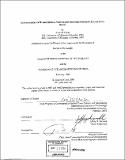| dc.contributor.advisor | Jeffrey S. Seewald. | en_US |
| dc.contributor.author | Cruse, Anna M. (Anna Marie) | en_US |
| dc.contributor.other | Woods Hole Oceanographic Institution. | en_US |
| dc.date.accessioned | 2007-10-19T20:24:50Z | |
| dc.date.available | 2007-10-19T20:24:50Z | |
| dc.date.copyright | 2003 | en_US |
| dc.date.issued | 2003 | en_US |
| dc.identifier.uri | http://hdl.handle.net/1721.1/39159 | |
| dc.description | Thesis (Ph. D.)--Joint Program in Oceanography/Applied Ocean Science and Engineering (Massachusetts Institute of Technology, Dept. of Earth, Atmospheric, and Planetary Sciences, and the Woods Hole Oceanographic Institution), 2003. | en_US |
| dc.description | Includes bibliographical references. | en_US |
| dc.description.abstract | The presence of aqueous organic compounds derived from sedimentary organic matter has the potential to influence a range of chemical processes in hydrothermal vent environments. For example, hydrothermal alteration experiments indicate that alteration of organic-rich sediments leads to up to an order of magnitude more metals in solution than alteration of organic-poor basalt. This result is in contrast to traditional models for the evolution of vent fluids at sediment-covered mid-ocean ridge axis environments, and indicates the fundamental importance of including the effects of organic compounds in models of crustal alteration processes. However, in order to rigorously constrain their role in crustal alteration processes, quantitative information on the abundances and distributions of organic compounds in hydrothermal vent fluids is required. This thesis was undertaken to provide quantitative information on the distributions and stable carbon isotopic compositions of several low-molecular weight organic compounds (C1-C4 alkanes, C2-C3 alkenes, benzene and toluene) in fluids collected in July, 2000, at three sites on the northern Juan de Fuca Ridge: the Dead Dog and ODP Mound fields, which are located at Middle Valley, and the Main Endeavour Field, located on the Endeavour segment. At Middle Valley, the ridge axis is covered by up to 1.5 km of hemipelagic sediment containing up to 0.5 wt. % organic carbon. The Main Endeavour Field (MEF) is located approximately 70 km south of Middle Valley in a sediment-free ridge-crest environment, but previously measured high concentrations of NH3 and isotopically light CH4 relative to other bare-rock sites suggest that the chemical composition of these fluids is affected by sub-seafloor alteration of sedimentary material (LILLEY et al., 1993). | en_US |
| dc.description.abstract | (cont.) Differences in the absolute and relative concentrations of NH3 and organic compounds and the stable carbon isotopic compositions of the C1-C3 organic compounds suggest that the three fields represent a continuum in terms of the extent of secondary alteration of the aqueous organic compounds, with the Dead Dog fluids the least altered, the MEF fluids the most altered and ODP Mound fluids in an intermediate state. At the two Middle Valley sites, the greater extent of alteration in the ODP Mound fluids as compared to the Dead Dog fluids is due either to higher temperatures in the subsurface reaction zone, or a greater residence time of the fluids at high temperatures. Higher reaction zone temperatures at the ODP Mound field than at the Dead Dog field are consistent with differences in endmember Cl concentrations between the two fields. The greater extent of alteration in the MEF fluids is caused by relatively oxidizing conditions in the subsurface reaction zone that promote faster reaction kinetics. Temperatures in the subsurface reaction zones calculated by assuming equilibrium among aqueous alkanes, alkenes and hydrogen are ... | en_US |
| dc.description.statementofresponsibility | by Anna M. Cruse. | en_US |
| dc.format.extent | 291 p. | en_US |
| dc.language.iso | eng | en_US |
| dc.publisher | Massachusetts Institute of Technology | en_US |
| dc.rights | M.I.T. theses are protected by copyright. They may be viewed from this source for any purpose, but reproduction or distribution in any format is prohibited without written permission. See provided URL for inquiries about permission. | en_US |
| dc.rights.uri | http://dspace.mit.edu/handle/1721.1/7582 | |
| dc.subject | /Woods Hole Oceanographic Institution. Joint Program in Oceanography/Applied Ocean Science and Engineering. | en_US |
| dc.subject | Earth, Atmospheric, and Planetary Sciences. | en_US |
| dc.subject | Woods Hole Oceanographic Institution. | en_US |
| dc.title | Geochemistry of hydrothermal vent fluids from the northern Juan De Fuca Ridge | en_US |
| dc.type | Thesis | en_US |
| dc.description.degree | Ph.D. | en_US |
| dc.contributor.department | Joint Program in Oceanography/Applied Ocean Science and Engineering | en_US |
| dc.contributor.department | Woods Hole Oceanographic Institution | en_US |
| dc.contributor.department | Massachusetts Institute of Technology. Department of Earth, Atmospheric, and Planetary Sciences | |
| dc.contributor.department | Massachusetts Institute of Technology. Department of Ocean Engineering | |
| dc.identifier.oclc | 52711436 | en_US |
